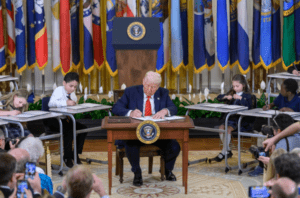When Linda McMahon was named Secretary of Education, her stated purpose was to work herself out of a job by shutting down the Department of Education (ED). The White House announced this week that she might be on the verge of doing just that.
For decades, Concerned Women for America (CWA) has looked forward to the day that the ED finally closes its shutters. Thanks to our longtime advocacy on this issue, we were even in the room when President Trump signed the executive order to shutdown ED earlier this year.

The fact is that the agency has been a blight on the American education system ever since its doors opened in 1979. Though viewed as an indispensable part of the nation’s school system, the ED has acted to coerce local jurisdictions into adopting policies that are bad for students, while preventing them from implementing strategies that would best serve their kids and communities. It has taken money from taxpayers and given it to Washington bureaucrats who think that they, and not parents, know what is best for kids.
One silver lining of the 43-day Schumer Shutdown, however, was that it proved just how unnecessary the Department of Education is to America’s schools. Despite 90% of its staff being furloughed, schools stayed opened. Special needs students received their services and buses continued to run on schedule. Teachers received their paychecks and school lunches were distributed as normal. The nation’s school children may not have even been aware of the shutdown if not for social media and smart phone news notifications.
That’s why this week, immediately following the government’s reopening, was the perfect time for the White House to announce that the Department’s final mission had, at long last, begun. The President does not have the ultimate authority to close any agency; that requires an act of Congress. But there is much that he and the Secretary can do to drastically downsize the ED. To that end, ED has now signed six new agreements with four other agencies, moving the bulk of the Department’s programs elsewhere.
One primary effect of establishing the ED was that an enormous amount of bureaucratic bloat was added to the national debt. Most of the programs that ED administers can be overseen far more efficiently by other agencies. Yet ED’s existence necessarily means that there are more bureaucrats than necessary handling duplicitous programs, something that the newly signed interagency agreements highlight.
For example, the State Department has long overseen the Fulbright Scholar program for international students, yet ED has, until now, administered the Fulbright grants for administrators and teachers. Now, all of the Fulbright Grant programs will be housed under State.
Health and Human Services (HHS) has signed two new agreements with ED. One establishes a program designed to better provide childcare access to parents in school. As HHS already manages the Head Start program, the largest federal childcare program, they have the expertise to ensure low-income students have access to these services. The second agreement deals with the accreditation of foreign medical schools, a natural fit for the agency that handles all other aspects of federal healthcare oversight.
Another of the new agreements moves oversight of Indian education programs to the Department of Interior, who has long had jurisdiction over every other program related to Indian Affairs except education. These are common sense ways to reduce government bloat and ensure that agencies with the right expertise are managing these programs with greater efficiency.
The red tape and bureaucratic barriers that Secretary McMahon is steadily cutting through have contributed not only to wasteful spending but also to unnecessarily tying the hands of localities and preventing them from meeting the unique needs of the students in their communities. One-size-fits-all prescriptions from bureaucrats in D.C. rarely fit the situation in both inner-city Houston and the rural backwoods of Maine.
Despite taxpayers subsidizing the education system to the tune of $195 billion dollars this year alone, K-12 academic scores have, at best, remained unchanged. In many cases though, academic progress has declined. The 2025 National Assessment of Education Progress (NAEP) math scores were the lowest that they have been since the test was first administered in 1992. And lest people blame COVID on the recently released scores, the new scores build on a decline that started happening years before the pandemic shuttered schools. There is a real crisis of learning in America, and the Department of Education is a roadblock in the way of addressing that critical issue.
By getting Washington out of the way of critical education decisions, the hope is that students will no longer be trapped in failing classrooms, and jurisdictions will no longer be forced to adhere to policies that do not work for their communities. Washington never should have been in the business of education. And soon, this 40+ year-long experiment will be over. It’s time to finish the job.






